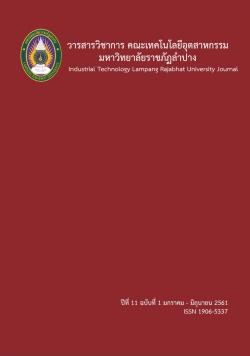การศึกษาประสิทธิภาพการกำจัดฝุ่นละอองด้วยระบบบำบัดอากาศแบบเปียกสำหรับโรงสีข้าวชุมชน
คำสำคัญ:
โรงสีข้าวชุมชน, สครับเบอร์แบบเปียก, ฝุ่นละออง, ตัวกลางดูดซึมบทคัดย่อ
งานวิจัยนี้ได้ศึกษาประสิทธิภาพการกำจัดฝุ่นละอองด้วยอุปกรณ์ดักจับฝุ่นชนิดสครับเบอร์แบบเปียกที่เหมาะสมสำหรับโรงสีข้าวชุมชนบ้านกาดเมฆ ตำบลชมพู อำเภอเมือง จังหวัดลำปาง เพื่อช่วยลดปัญหาฝุ่นละอองที่ฟุ้งกระจายในอากาศซึ่งเป็นปัญหามลพิษทางอากาศในเขตพื้นที่ชุมชน โดยทำการศึกษาค่าความหนาแน่นของฝุ่นละอองจากการสีข้าวของโรงสีข้าวชุมชน ผลการศึกษาค่าความหนาแน่นของฝุ่นละอองจากการสีข้าวของโรงสีข้าวชุมชนพบว่าค่าความหนาแน่นฝุ่นละอองขณะเดินระบบ สีข้าวมีค่า 1.12 mg/m3 เกินค่ามาตรฐาน ซึ่งค่ามาตรฐานฝุ่นละออง ณ จุดปล่อยกำหนดไว้ไม่เกิน 0.10 mg/m3 ความเร็วลมในท่อระบายอากาศเสีย อัตราการไหลของน้ำที่เหมาะสมต่ออัตราการไหล ของอากาศ รวมทั้งทำการออกแบบตัวกลางดูดซึมชนิด Ceramic berl saddle นำข้อมูลที่ได้มาทำการออกแบบ สครับเบอร์แบบเปียกด้วยโปรแกรมสำเร็จรูป Scrubber design สครับเบอร์แบบเปียกที่ออกแบบมีพื้นที่หน้าตัดของตัวถังเท่ากับ 0.25 m2 และความยาว 1.5 m ตัวกลางดูดซึมชนิด Ceramic berl saddle ทำจากดินเบาเผาที่อุณหภูมิ 900 องศาเซลเซียส มีประสิทธิภาพในการดูดซึมน้ำและฝุ่นดีที่สุด สามารถลดปริมาณฝุ่นละอองที่เกิดจากระบวนการ สีข้าวของโรงสีข้าวชุมชนได้ถึง ร้อยละ 91 ที่ระดับแรงดันของน้ำสเปรย์ 0.30 bar
เอกสารอ้างอิง
of Natural Resources and Environment. Retrieved March 10, 2015, from http://www.pcd.go.th/info_serv/reg_std_airsnd01.html (in Thai)
Charnpittaya Chim Pali. (2015). Thailand's rice industry from 2015 to 2016 : Direction and potential of Thai rice production. Bureau of Rice Policy and Strategy. Retrieved May 25, 2015, from http://www.dft.go.th/LinkClick.aspx?fileticket=p6iLTgSSD_4%3D&tabid (in Thai)
Bunnak, C., (2013). Lampang campaign campaign to keep the villagers planted 7 plants from only 3 species. Manager Online. Retrieved June 5, 2013, from http://www.manager.co.th/Local/ViewNews.aspx?NewsID=9560000095 (in Thai)
Cheowchan, P., (2009). Air pollution control equipment. School of Health Sciences Sukhothai Thammathirat Open University. Received June 5, 2013, from https://www.safety-stou.com/UserFiles/File/54114-5.PDF (in Thai)
Kanokananapong, W., (2008). Particle Collection Devices. Huachiew Chalermprakiet University Journal, 11(22), 79-92 (in Thai)
A.G. Bhave, D.K. Vyas and J.B. Patel1. (2007). A wet packed bed scrubber-based producer gas cooling–cleaning system. Received February 15, 2013, from https://www.cabdirect.org/cabdirect/abstract/20083243939
Choi, K.-I. and Lee, D.-H. (2007). PCDD/DF concentrations at the inlets and outlets of wet scrubbers in Korean waste incinerators. Chemosphere, 66: 370–376.
Deshwal, B.R., D.S. Jin, S.H. Lee. (2008). Removal of NO from flue gas by aqueous chlorine-dioxide scrubbing solution in a lab-scale bubbling reactor. J. Hazard. Mater, 150649–655.
Jin. (2006). Simultaneous removal of SO2 and NO by wet scrubbing using aqueous chlorine dioxide solution. J. Hazard. Mater, 135: 412–417.
K., S.J. Chung, T. Raju, Chandrasekara Pillai. (2009). Experimental aspects of combined NOx and SO2 removal from flue-gas mixture in an integrated wet scrubber–electrochemical cell system. Chemosphere, 76: 57–664.
Meikap, B.C. (2002). Scrubbing of fly-ash laden SO2 in modified multistage bubble column scrubber. AIChE J, 48: 2074–2083.
Ngala G. M. Sulaiman A. I. and Sani M. U. (2008). Air Pollution Control in Cement Factory Using Horizontal Type Wet Scrubber. Continental Journal of Applied Sciences. 3(1).
Raj Mohan, B. and Meikap, B.C. (2009). Performance studies of the particulate scrubbing in a novel spray-cum-bubble column scrubber. Chem. Eng. Res. Design, 87: 109–118.
Ritunesh Kumar,P.L. and Dhar,Sanjeev Jain. (2010). Development of new wire mesh packings for improving the performance of zero carryover spray tower. Energy 36 (2011) 1362 – 1374.
Sarkar. (2007). Modeling of removal of sulfur dioxide from flue gases in a horizontal cocurrent gas–liquid scrubber. Chem. Eng. J, 131: 263–271.






